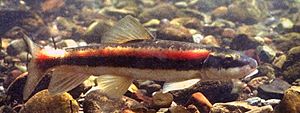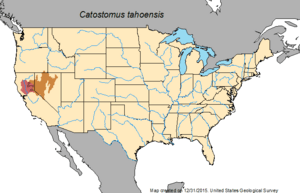Tahoe sucker facts for kids
Quick facts for kids Tahoe sucker |
|
|---|---|
 |
|
| Conservation status | |
| Scientific classification | |
| Genus: |
Catostomus
|
| Species: |
tahoensis
|
 |
|
| Known watershed locations of Catostomus tahoensis | |
| Synonyms | |
|
Catostomus arenarius Snyder, 1917 |
|
The Tahoe sucker (Catostomus tahoensis) is a type of freshwater fish. It lives in the Great Basin area of the Western United States. This fish is known for its special mouth that helps it feed.
Contents
What Does the Tahoe Sucker Look Like?
The Tahoe sucker is a long fish with a body that gets thinner towards its head. It can grow quite large, up to 24 inches (about 60 cm) in bigger lakes. Its mouth is located on the bottom of its head and is shaped like a suckermouth. This helps it suck up food.
The tail fin, called the caudal fin, is slightly forked. This means it has a small split in the middle. The fish has between 83 and 87 scales along its lateral line. This line helps the fish sense movement in the water.
Tahoe suckers are usually very dark on top and lighter underneath. Their fins are also a bit dark. When males are ready to breed, they get a bright red line along their sides.
Where Do Tahoe Suckers Live?
These fish are originally from the Lahontan Basin. This area includes parts of southeastern Oregon, Nevada, and northeastern California. The Tahoe sucker is one of the most common fish found there. It has also been moved to the upper Sacramento River system.
Scientists believe there are more than 100,000 adult Tahoe suckers. They are very common in their different homes. These fish mostly live in large lakes and reservoirs. You can also find them in ponds in the lower parts of streams. Adult fish prefer deeper waters. Young fish, however, stay in shallow areas or smaller streams that flow into larger bodies of water.
What Do Tahoe Suckers Eat?
Tahoe suckers mostly eat plants, which means they are herbivores. However, they also eat small insects and tiny water creatures called micro-crustaceans.
Life Cycle and Reproduction
Tahoe suckers become old enough to have babies when they are between 2 and 5 years old. Male fish usually mature earlier than females. The age they mature can be different depending on where they live. For example, fish in Pyramid Lake mature a few years earlier than those in Lake Tahoe.
How many eggs a female can lay seems to depend on her size, with age being less important. Before the mating season, small bumps called nuptial tubercles appear on both male and female fish. These bumps are rare on females. On males, they form clear rows on their anal and caudal fins.
Tahoe suckers like to spawn (lay eggs) over rocks and gravel. The female scatters her eggs into the gravel bed. Then, she shakes them down into the gravel. At the same time, the male fish release their sperm to fertilize the eggs.
Tahoe Suckers and People
Long ago, the native Paiute people did not usually eat Tahoe suckers. They preferred other fish like Cutthroat trout and Cui-ui sucker. Even though the Tahoe sucker is a good size and tastes good, it is not important for fishing or business today.
- Froese, Rainer, and Daniel Pauly, eds. (2016). "Catostomus tahoensis" in FishBase. 01 2016 version.
See also
 In Spanish: Catostomus tahoensis para niños
In Spanish: Catostomus tahoensis para niños


